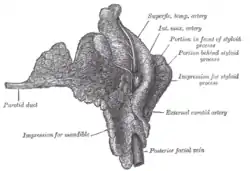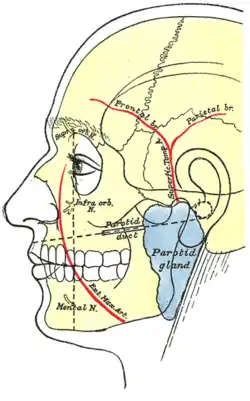Parotid duct
The parotid duct or Stensen duct is a duct and the route that saliva takes from the major salivary gland, the parotid gland, into the mouth.[1]
| Parotid duct | |
|---|---|
 Right parotid gland. Deep and anterior aspects. (Parotid duct labeled at center left.) | |
 Dissection, showing salivary glands of right side. (Parotid duct visible at center.) | |
| Details | |
| Identifiers | |
| Latin | Ductus parotideus |
| TA98 | A05.1.02.007 |
| TA2 | 2805 |
| FMA | 10420 |
| Anatomical terminology | |
Structure
The parotid duct is formed when several interlobular ducts—the largest ducts inside the parotid gland—join. It emerges from the gland and runs forward along the lateral side of the masseter muscle. In this course, the duct is surrounded by the buccal fat pad.[2] It takes a steep turn at the border of the masseter and passes through the buccinator muscle, opening into the vestibule of the mouth, the region of the mouth between the cheek and the gums, at the parotid papilla, which lies across the second Maxillary (upper) molar tooth.[3]
The buccinator acts as a valve that prevents air forcing into the duct, which would cause pneumoparotitis.[4] Running along with the duct superiorly is the transverse facial artery and upper buccal nerve; running along with the duct inferiorly is the lower buccal nerve.
The exit of the parotid ducts can be felt as small bumps (Papillae) on both sides of the mouth, and are usually positioned next to the maxillary second molars.
Clinical significance
Blockage, whether caused by salivary duct stones or external compression, may cause pain and swelling of the parotid gland (parotitis).
Koplik's spots which are pathognomonic of measles are found near the opening of the parotid duct.
Name
The parotid duct is named after Nicolas Steno (1638–1686), also known as Niels Stensen, a Danish anatomist (albeit best known as a geologist) credited with its detailed description in 1660.[5]
Additional images
 Outline of side of face, showing chief surface markings.
Outline of side of face, showing chief surface markings. Microscopic slide of a human interlobular duct.
Microscopic slide of a human interlobular duct. Microscopic slide of a human striated duct.
Microscopic slide of a human striated duct. The left papilla (soft tissue protuberance at the exit) of the parotid duct is clearly visible on the cheek in the right of the photo.
The left papilla (soft tissue protuberance at the exit) of the parotid duct is clearly visible on the cheek in the right of the photo. Parotid duct
Parotid duct Parotid duct
Parotid duct Parotid duct
Parotid duct
See also
References
- Nanci A (2013). Ten Cate's Oral Histology: Development, Structure, and Function. Elsevier. p. 255. ISBN 978-0-323-07846-7.
- Latarjet M, Ruiz Liard A (2005). Human Anatomy (Spanish Edition). Editorial Médica Panamericana. ISBN 978-950-06-1368-2.
- Bath-Balogh M, Fehrenbach MJ (2011). Illustrated Dental Embryology, Histology, and Anatomy, Bath-Balogh and Fehrenbach,. Elsevier. p. 135. ISBN 978-1-4377-1730-3.
- Faizal B, Chandran MP (2012). "Pneumoparotitis" (PDF). Amrita Journal of Medicine. 8 (2): 1–44. Archived from the original (PDF) on 2015-12-11.
- Natale G, Bocci G, Ribatti D (September 2017). "Scholars and scientists in the history of the lymphatic system". Journal of Anatomy. 231 (3): 417–429. doi:10.1111/joa.12644. PMC 5554832. PMID 28614587.
Further reading
- Casseri GC (1627). Tabulae anatomicae, lxxiix. Venetis.
- Stensen N (1662). Observationes anatomicae, quibus varia oris, oculorum & narium vas describuntur novique salivae, lacrymarum & muci fontes deteguntur. Lugduni Batavorum: J. Chouët.
External links
- Diagram at MSU
- ent/178 at eMedicine - Parotid duct injuries
- doctor/2052 at Who Named It?